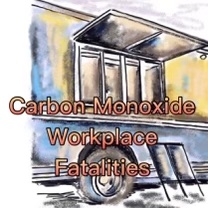Carbon Monoxide At Work Results in Death and Brain Damage
Carbon monoxide at work can result in death or brain damage because one doesn’t have to be asleep to be poisoned.
By Rebecca Martin
We emphasize over and over that carbon monoxide detectors should be installed in any place where people sleep but carbon monoxide at work is also common. While when sleeping is when we are perceived to be the most vulnerable carbon monoxide at work can happen in such high levels that death may happen quickly. Always remember that carbon monoxide fatalities or can occur in any place where fuel-burning devices are in operation.

Carbon monoxide can strike at atypical work places like a food truck.
An average of 22 people lose their lives to carbon monoxide exposure in the workplace annually. According to a manuscript entitled Occupational Carbon Monoxide Fatalities in the US From Unintentional Non-Fire Related Exposures, 1992-2008, the source of most of these fatalities is motor vehicles, followed by heating systems and generators. For every one person who dies from an exposure to CO, there are 20 to 50 who suffer permanent brain damage. CO poisoning is not a binary choice: it isn’t whether you survive, but how much organ and brain damage occurs in those who live. https://www.ncbi.nlm.nih.gov/pmc/articles/PMC4552320/
Carbon Monoxide at Work in the News
The dangers of carbon monoxide at work were highlighted in February of 2023 with two news stories that raised concerns over occupational safety.
The first story comes from the UK and raises concerns here in the United States over food truck safety. 50-year-old Leah Churchill and her 17-year-old daughter Brooke Wanstall were discovered the morning of February 14 by Leah’s son, Tyla Wanstall. The mother and daughter had been working overnight decorating Tyla’s food truck as a surprise for his birthday. Not realizing the danger of starting the generator inside the truck which was stored in the truck only overnight for security purposes, it is assumed that they intended to stay warm while completing the decorations and succumbed to carbon monoxide poisoning. https://www.newsweek.com/mom-daughter-dead-burger-van-truck-whitstable-son-birthday-uk-1781354
Generators Do Not Belong in Vehicles
There have been questions raised about the safety of food truck employees in general. When we consider that half of hurricane fatalities are due to the improper use of generators, how safe are food truck generators? We see recommendations for home use which begin with placement of generators at least 15 feet away from the home and safe distances from any possibility of entering a neighboring home through vents, windows and doors. Some areas provide electric hook ups for food trucks and anti-idling laws in some communities have helped curb air quality concerns in areas where multiple trucks gather. Brian Urbaszewski at the Respiratory Health Association says
“Running generators without the best exhaust pollution control equipment is going to expose people to unnecessarily high levels of air pollution that could affect their health. Since asthma rates are still rising, we should be doing everything we can to reduce the pollution that can make people sick or send them to the hospital. While it’s not healthy for the customers, or those living or working nearby, it’s even worse for the employees who are the most exposed to pollution all day long.” https://chicagoist.com/2012/09/02/should_we_be_concerned_about_food_t.php
Truck drivers are also at risk for carbon monoxide exposure. There have been cases of truck drivers falling ill or dying due to carbon monoxide in their trucks. Some drivers carry heaters in their trucks which can cause carbon monoxide build up in close quarters and faulty or unmaintained exhaust systems can also be a source of carbon monoxide poisoning.
Gas Power Tools can Cause Carbon Monoxide at Work
A Canton Township, Michigan shop owner died February 21, 2023 due to suspected carbon monoxide poisoning. The 60-year-old man had been working in his automotive shop when he was found unresponsive by an employee. Efforts to revive him were unsuccessful. The level of carbon monoxide at the scene was extremely high. The employee, three police officers and four firefighters were subsequently evaluated for carbon monoxide poisoning. The source was thought to be a running vehicle in the building. https://www.detroitnews.com/story/news/local/wayne-county/2023/02/21/canton-shop-owner-dies-of-suspected-carbon-monoxide-poisoning/69929579007/
There are several occupations which involve a higher risk of carbon monoxide poisoning.
“Occupations that are known to have greater risk for CO poisoning include jobs that require working around combustion sources such as engines and fires and include mechanics, firefighters, longshore workers, diesel engine and forklift operators, and tunnel or toll booth attendants. Other occupations that have been largely overlooked but also carry risk for CO exposure include those as varied as warehouse workers, who use propane or diesel forklifts, and restaurant workers, such as charcoal meat grillers and indoor barbeque workers.” https://www.ncbi.nlm.nih.gov/pmc/articles/PMC5649989/
The fact is that any occupation which involves fuel-burning devices is at risk from carbon monoxide poisoning. It might be a defective boiler in a school, a landscaping device running outside a church, or construction devices left running in a hotel. It is not just the places we sleep that are at risk.
There are many ways to make a workplace more secure from the threat of carbon monoxide poisoning.
- First, is to install carbon monoxide detectors in locations recommended by a building inspector. Personal carbon monoxide detectors can be worn by employees in high-risk situations as well as supplying access to personal breathing apparatus.
- Second, sufficient and effective ventilation systems should be in place and gas-powered equipment should not be operated indoors or in poorly ventilated areas.
- Third, proper regular preventative maintenance of all fuel-burning devices is essential.
- Best yet, considering the replacement of gas-powered devices with alternative power sources should be considered.
Staff should be educated in the signs and symptoms of carbon monoxide exposure and response to the presence of carbon monoxide taken with the utmost seriousness.
A full list of employer and employee responsibility is available at https://www.osha.gov/sites/default/files/publications/carbonmonoxide-factsheet.pdf

Leave a Reply
Want to join the discussion?Feel free to contribute!